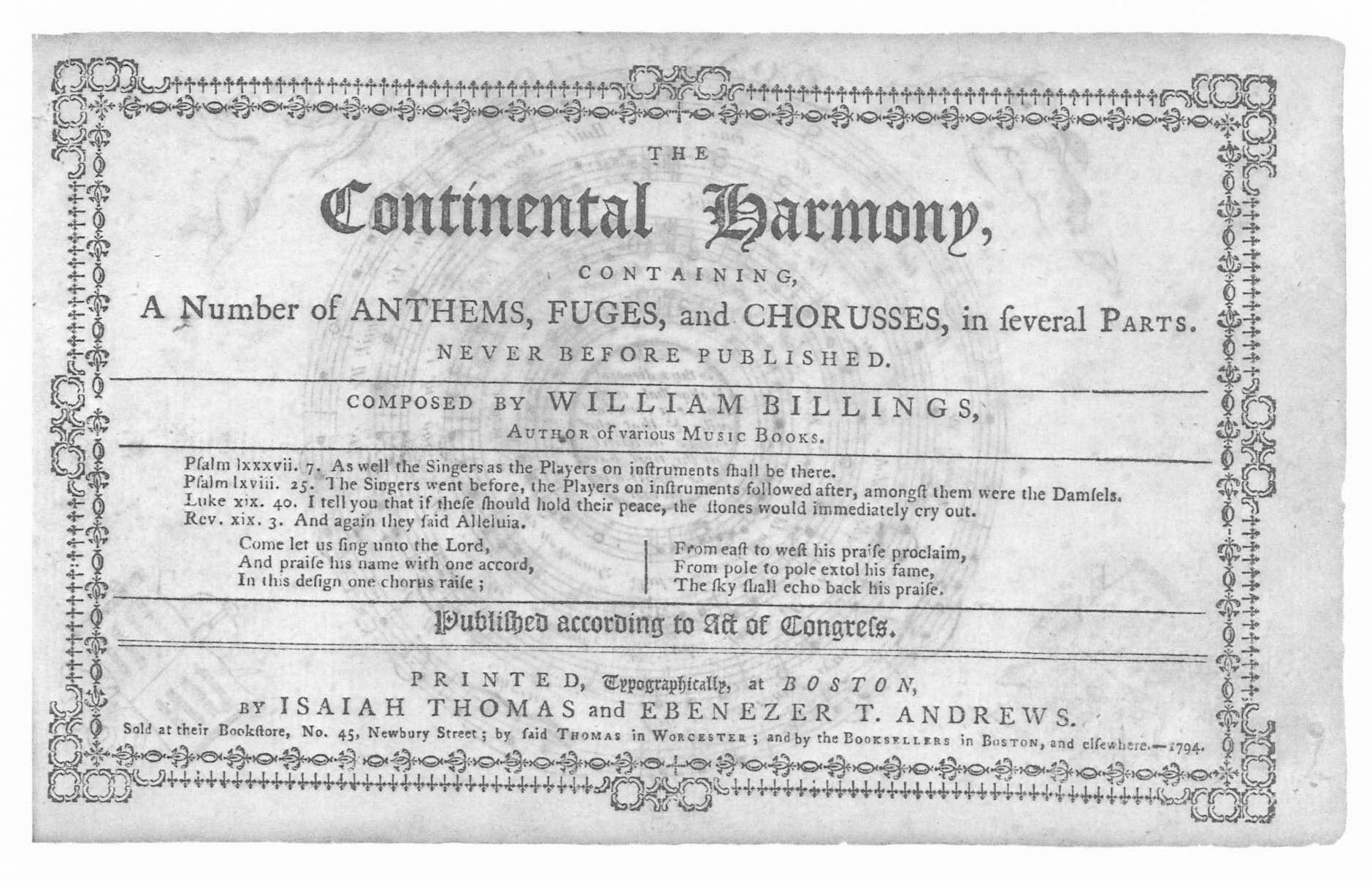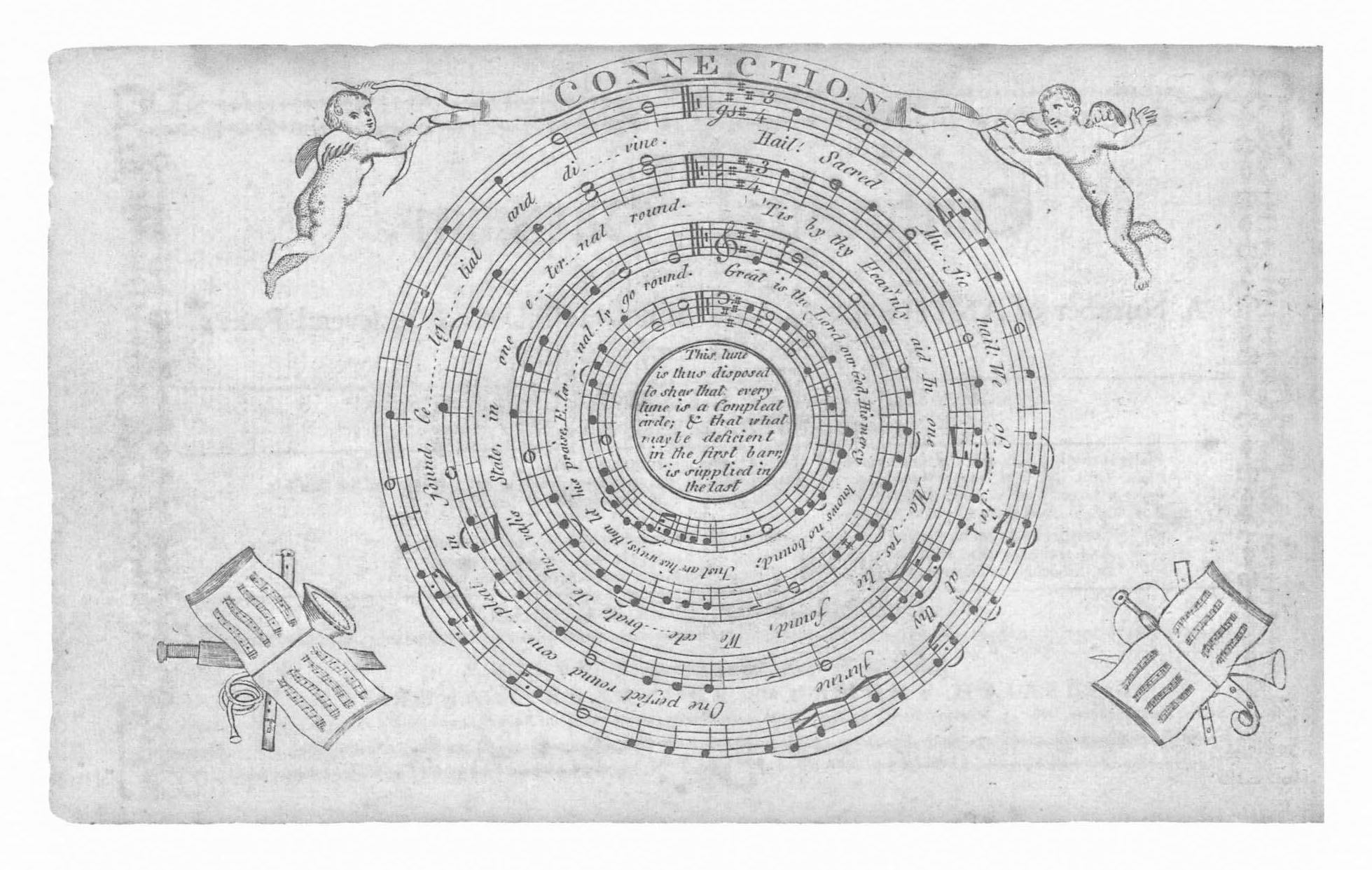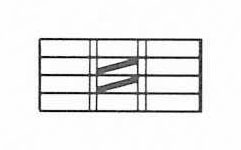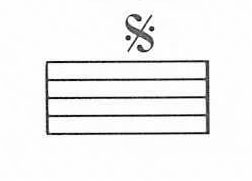Billings’s Introduction to The Continental Harmony
To the several TEACHERS of MUSIC, in this and the adjacent States.282
My BRETHREN,
I HAVE drawn up the rules of practical music, as concise as the nature of the thing would admit, and have inserted them in course, as they should be taught; I recommend it to you to teach after the manner they are inserted; it being the best method I have yet found, from long experience.
lesson i.283 The gamut
| For Tenor or Treble. | For Counter. | For Bass. |
|---|---|---|
|
G sol. |
A la. |
C——fa. |
|
F——fa. |
G——sol. |
B mi. |
|
E la. |
F fa. |
A——la. |
|
D——sol. |
E——la. |
G sol. |
|
C fa. |
D sol. |
F——fa. |
|
B——mi. |
C——fa. |
E la. |
|
A la. |
B mi. |
D——sol. |
|
G——sol. |
A——la. |
C fa. |
|
F fa. |
G sol. |
B——mi. |
|
E——la. |
F——fa. |
A la. |
|
D sol. |
E la. |
G——sol. |
|
F fa. |
Observe, that from E to F, and from B to C, are half notes ascending, and from F to E, and from C to B, descending; so that an octave consists of five whole, and two half notes. Likewise be very careful to make a proper distinction between the sound of B mi, and C fa; for many singers, who have not curious ears, are apt to strike B mi, as high as C fa, in sharp keyed tunes, which ruins the composition.
lesson ii. On transposition.
The natural place for mi is in B; but if B be flat, mi is in E; if B and E be flat mi is in A; if B E and A be flat, mi is in D; if B E A and D be flat, mi is in G. If F be sharp, mi is in F; if F and C be sharp, mi is in C; if F C and G be sharp, mi is in G; if F C G and D be sharp, mi is in D. And when you have found mi in any of these variations, the notes above are fa, sol, la, fa[,] sol, la, and then comes mi again; and the notes below mi, are la, sol, fa, la, sol, fa, and then comes mi again.
lesson iii. on cliffs.284
The bass cliff is always fixed on the upper line but one; it gives the line it stands upon the name of F.
F Cliff.
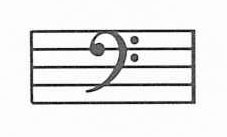
The tenor cliff is fixed in my work on the lowest line but one; it gives the line it stands upon the name of G; and if it be removed to any other line, it removes G with it.
G Cliff.
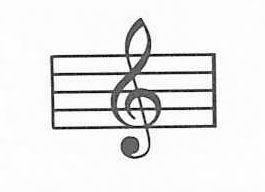
The counter cliff stands upon the middle line, in my work, but if it is removed to any other line, it gives the line it stands upon the name of C.
The treble cliff is fixed on the lower line but one, and it gives the line it stands upon the name of G. This cliff is never removed, but stands fixed an octave above the tenor.
G Cliff.
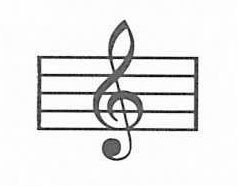
N. B. According to these cliffs, a note on the middle line in the tenor, is a sixth above a note on the middle line of the bass; a note on the middle line of the treble, is a thirteenth above the middle line of the bass, and an eighth above the middle line of the tenor; a note on the middle line of the counter, is a seventh above the middle line of the bass, and one note above the middle line of the tenor, and a seventh below the middle line of the treble.
☞ To find the octave to any sound, add seven to it, viz. The octave to a third, is a tenth, and the octave to a fourth, is an eleventh, &c. &c.
lesson iv. On characters.
THE names of the six musical notes now in use, and how they are proportioned from each other, together with their respective rests.
1st. The Semibreve, which is the longest note now in use, though formerly the shortest; this note when set in the adagio mood, is to be sounded four seconds, or as long as four vibrations of the pendulum, which is 392/10 inches long. This is the measure note, and guideth all the rest; it is shaped something like the letter O.
Semibreve.
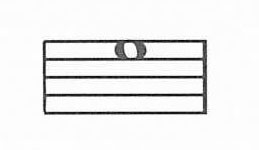
2d. The Minum is but half the length of the semibreve, having a tail to it.
Minum.
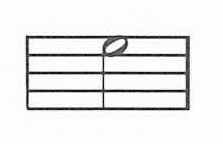
3d. The Crotchet is but half the length of the minum, having a black head.
Crotchet.
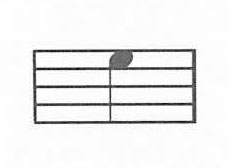
4th. The Quaver is but half the length of the crotchet, having the tail turned up at the end, except there are two or three, or more together, and then one stroke serves to tie them all.
Quaver.
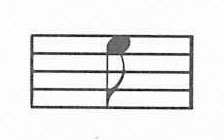
5th. The Semiquaver is but half the length of the quaver, having the tail turned up with two strokes.
Semiquaver.
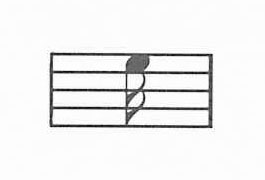
6th. The Demisemiquaver is but half the length of the semiquaver, having the tail turned up with three strokes; this is the shortest note now in use.
Demisemiquaver.
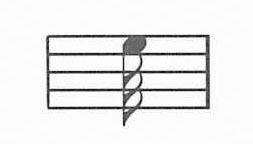
A Rest is a note of silence, which signifies that you must rest, or keep silence as long as you would be sounding one of the notes it is intended to represent. The rest which is set to the semibreve should be called a bar rest, because it is used to fill an empty bar in all moods of time.
A Prick of Perfection is not well named in my opinion, because a note may be perfect without it; a Point of Addition is the best name; because it adds one third to the time of any note; for a pointed semibreve contains three minums, a pointed minum contains three crotchets, a pointed crotchet contains three quavers, a pointed quaver contains three semiquavers, and a pointed semiquaver contains three demisemiquavers.
Point of Addition.
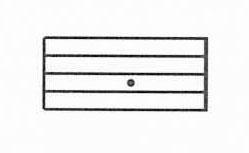
lesson v. On the second Lesson of characters.
1st. A Flat serves to sink a note half a tone lower than it was before, and flats set at the beginning serve to flat all notes that are inserted on that line or space, unless contradicted by an accidental sharp or natural. Likewise they are used to drive mi, from one place to another.
A Flat.
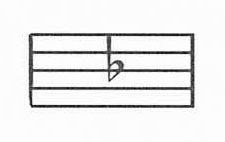
2d. A Sharp serves to raise a note half a tone higher than it was before, and sharps set at the beginning of the staff serve to sharp all notes which occur on that line or space, unless contradicted by an accidental flat or natural. They are also used to draw mi from one place to another.
A Sharp.
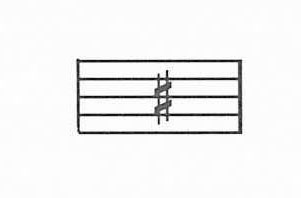
3d. A Repeat is to direct the performer, that such a part is to be repeated over again, that is, you must look back to the first repeat, and perform all the notes that are between the two repeats over again; it is also used in canons to direct the following parts to fall in at such notes as it is placed over.
4th. A Slur is in form like a bow, drawn over, or under the heads of two, three, or more notes, when they are to be sung to but one syllable.
A Slur.
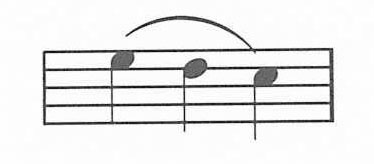
5th. A Bar is to divide the time in music, according to the mood in which the tune is set; it is also used to direct the performers in beating time; for the hand must be always falling in the first part of a bar, and rising in the last part, both in common and triple time; it is also intended to shew where the accents fall, which are always in the first and third part of the bar, in common time, and in the first part of the bar in triple time.
A Bar.
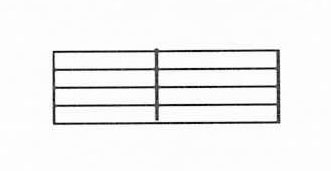
6th. A Direct is placed at the end of the staff, to direct the performer to the place of the first note in the next staff.
Direct.
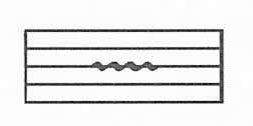
7th. A Natural is a mark of restoration, which being set before any note that was made flat, or sharp, at the beginning, restores it to its former natural tone; but not to its natural name, as many have imagined, unless it is set at the beginning of a strain, which was made flat, or sharp, and then it restores it to its former natural key.
Natural.
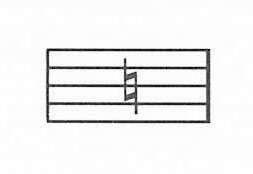
8th. A Mark of Distinction is set over a note, when it is to be struck distinct and emphatic, without using the grace of transition.
Mark of Distinction.

N. B. This character, when properly applied and rightly performed, is very majestic.
9th. A close is made up of three, four or more bars, and [is] always set at the end of a tune; it signifies a conclusion.
Close.
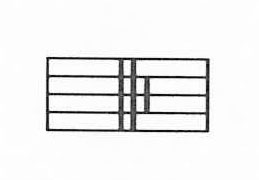
lesson vi. An Explanation of the several moods of time.
THE first, or slowest mood of time, is called Adagio, each bar containing to the amount of one semibreve: four seconds of time are required to perform each bar; I recommend crotchet beating in this mood, performed in the following manner, viz. first strike the ends of the fingers, secondly, the heel of the hand, then thirdly, raise your hand a little and shut it up, and fourthly, raise your hand still higher and throw it open at the same time. These motions are called two down and two up, or crotchet beating. A pendulum to beat crotchets in this mood should be thirty-nine inches and two tenths.
Adagio.
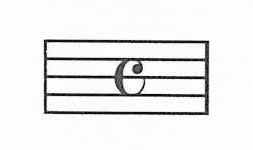
The second mood is called Largo, which is in proportion to the adagio as 5 is to 4. You may beat this two several ways, either once down and once up, in every bar, which is called minum beating, or twice down and twice up, which is called crotchet beating; the same way you beat the adagio. Where the tune consists chiefly of minums, I recommend minum beating; but where it is made up of less notes, I recommend crotchet beating: the length of the pendulum to beat minums in this mood, must be seven feet, four inches and two tenths; and the pendulum to beat crotchets, must be twenty-two inches and one twentieth of an inch.285
Largo.
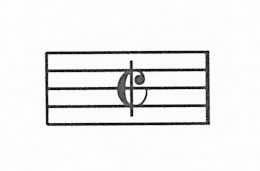
N. B. When I think it adviseable to beat largo in minum beating, I write “minum beating,” over the top of the tune, and where these words are not wrote, you may beat crotchet beating.
The third mood is called Allegro,286 it is as quick again as adagio, so that minums are sung to the time of seconds. This is performed in minum beating, viz. one down and one up; the pendulum to beat minums must be thirty-nine inches and two tenths.
Allegro.
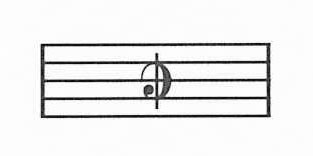
The fourth mood is called Two from Four, marked thus, 2/4, each bar containing two crotchets; a crotchet is performed in the time of half a second; this is performed in crotchet beating, viz. one down and one up. The pendulum to beat crotchets in this mood must be nine inches and eight tenths long.
2 from 4.
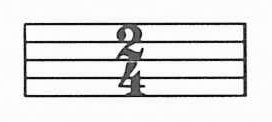
N. B. The four above mentioned moods are all common time.
The next mood is called Six to Four, marked thus, 6/4, each bar containing six crotchets; three beat down and three up. The pendulum to beat three crotchets in this mood, must be twenty-two inches and one twentieth.287
6 to 4.
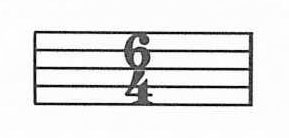
The next mood is called Six from Eight, marked thus, 6/8, each bar containing six quavers, three beat down and three up. The pendulum to beat three quavers, in this mood, must be twenty-two inches and one twentieth.
6 from 8.
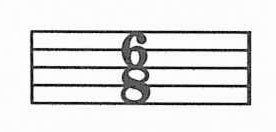
N. B. The two last moods are neither common nor triple time; but compounded of both, and, in my opinion, they are very beautiful movements.
The next mood is called Three to Two, marked thus, 3/2, each bar containing three minums, two to be beat down and one up; the motions are made after the following manner, viz. let your hand fall; and observe first to strike the ends of your fingers, then secondly the heel of your hand, and thirdly raise your hand up, which finishes the bar: these motions must be made in equal times, not allowing more time to one motion than another. The pendulum that will beat minums in this mood, must be thirty-nine inches and two tenths long.
3 to 2.
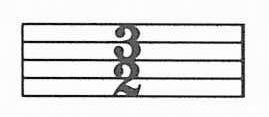
The next mood is called Three from Four, marked thus, 3/4, each bar containing three crotchets, two beat down and one up. The pendulum to beat crotchets in this mood, must be twenty-two inches and one twentieth long.
3 from 4.
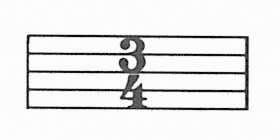
The same motion is used in this mood, that was laid down in 3/2, only quicker, according to the pendulum.
The next mood is called three from eight, marked thus 3/8, each bar containing three quavers, two beat down and one up. The pendulum to beat whole bars in this mood must be four feet, two inches, and two tenths of an inch long. The same motion is used for three from eight, as for three from four, only quicker; and in this mood you must make three motions of the hand, for every swing of the pendulum.
3 from 8.
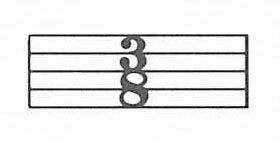
N. B. This is but an indifferent mood, and almost out of use in vocal music.
N. B. The three last mentioned moods are all in triple time, and the reason why they are called triple, is, because they are three-fold, or measured by threes; for the meaning of the word triple is three-fold: And common time is measured by even numbers, as 2—4—8—16—32—viz. 2 minums, 4 crotchets, 8 quavers, 16 semiquavers, or 32 demisemiquavers, are included in each bar, either of which amounts to but one semibreve: therefore the semibreve is called the measure note; because all moods are measured by it in the following manner, viz. The fourth mood in common time is called two from four, and why is it called so? I answer; because the upper figure implies that there are two notes of some kind included in each bar, and the lower figure informs you how many of the same sort it takes to make one semibreve. And in 3/8 the upper figure tells you, that there are three notes contained in a bar, and the lower figure will determine them to be quavers; because it takes 8 quavers to make one semibreve.
N. B. This rule will hold good in all moods of time.
Observe, that when you meet with three notes tied together with the figure three over them or under them, you must sound them in the same time you would two of the same sort of notes, without the figure. Note, that this character is in direct opposition to the point of addition; for as that adds one third of the time to the note which is pointed, so this diminishes one third of the time of the notes over which it is placed; therefore I think this character may, with much propriety, be called the character of diminution.
Likewise, you will often meet with the figures 1, 2, the figure one standing over one bar, and figure two standing over the next bar, which signifies a repeat; and observe, that in singing that strain, the first time you perform the bar under figure 1, and omit the bar under figure 2, and in repeating you perform the bar under figure 2, and omit the bar under figure 1, which is so contrived to fill out the bars; for the bar under figure 1 is not always full, without borrowing a beat, or half a beat, &c. from the first bar which is repeated, whereas the bar under figure 2, is or ought to be full, without borrowing from any other but the first bar in the tune, and if the first bar is full, the bar under figure 2 must be full likewise. Be very careful to strike in proper upon a half beat, but this is much easier obtained by practice than precept, provided you have an able teacher.
[lesson vii.]288
Syncope, syncopation, or driving notes, either through bars, or through each other, are subjects that have not been sufficiently explained by any writers I have met with; therefore I shall be very particular, and give you several examples, together with their variations and explanations.
Example first. The time is Allegro, and the bar is filled with a minum between two crotchets; you must take half the time of the minum, and carry it back to the first crotchet, and the last half to the last crotchet, and then it will be equal to two crotchets in each beat.

In the second example the time is Allegro, and the bar is filled with a crotchet before a pointed minum; take half the minum and carry back to the crotchet, which makes one beat; then the last half of the minum, together with the point of addition, completes the last beat.
Example 2d.

In example third,289 you will find a minum in one bar, tied to a point of addition in the next bar, which signifies that the sound of the pointed minum is continued the length of a crotchet into the next bar; but the time which is occasioned by the point of addition, is to help fill the bar it stands in.
Example fourth is the same in 2/4 as the first in Allegro.
Syncope, Example 4th.

Example fifth is the same as example second.

Example sixth is the same in 3/2 as example third in Allegro.
Example 6th.

Example seventh is in 3/2, as difficult as any part of syncope; therefore I have given several variations from the example, in which the bar is filled with two pointed minums, which must be divided into three parts, in the following manner, viz. The first minum must be beat with the ends of the fingers; secondly, the point of addition, and the first half of the last minum, must be beat with the heel of the hand; and thirdly, the last half of the last minum, together with the point of addition, must be beat with the hand rising; and in the several variations you must divide the notes into three equal parts, so as to have one minum in each beat: And in all the examples with their variations, you must first inform yourself what particular note goes for one beat, whether minum, crotchet or quaver, and then divide the syncopated note accordingly.

As this subject has not been very fairly explained by any of our modern authors, I have great reason to think it is not well understood; I therefore recommend it to all teachers, to insist very much on this part of practical music; it is a very essential part of their office: And if any who sustain the office of teachers, should not be able to perform this branch of their business by the help of these examples (for their honour and their pupils[’] interest) I advise such semi-teachers to resign their office, and put themselves under some able master, and never presume to commence teachers again, until they thoroughly understand both syncope and syncopation, in all their variations.
N. B. The same examples of syncope and syncopation, which are set down in 3/2, you may have in 3/4; only observe to substitute minums for semibreves; crotchets for minums; and quavers for crotchets; and in 3/8 you must make the notes as short again as they are in 3/4.
☞ When you meet with two or three notes standing one over the other, they are called chusing notes, and signify that you may sing which you please, or all, if your part has performers enough, and remember that they add not to the time, but to the variety.
lesson viii.
THERE are but two natural primitive keys in music, viz. A, the flat key, and C, the sharp key. No tune can be formed rightly and truly, but on one of these two keys, except the mi be transposed by flats or sharps, which bring them to the same effect as the two natural keys. B mi, must always be one note above, or one note below the key: if above, then it is a flat key; and if below, then it is a sharp key. But to speak more simply, if the last note in the bass, which is the key note, is named fa, then it is a sharp key, and if la, then it is a flat key; and observe, that it cannot end properly with mi or sol.
N. B. It is very essential that these two keys should be well understood; they must be strictly enquired into by all musical practitioners; for without a good understanding of their different natures, no person can be a judge of music. The different effects they have upon people of different constitutions, are surprizing, as well as diverting. As music is said to cure several disorders, if I was to undertake for the patients, I should chuse rather to inject these two keys into their ears, to operate on their auditory, than to prescribe after the common custom of Physicians.
☞ Choristers must always remember to set flat keyed tunes to melancholy words, and sharp keyed tunes to cheerful words.
A COMMENTARY ON THE PRECEDING RULES; BY WAY OF DIALOGUE, BETWEEN MASTER AND SCHOLAR.
Scholar. SIR, I have for some time past been wishing for a favourable opportunity to be better instructed by you; I have read over your rules, and although I think that they are very explicit, yet I confess I am not so well versed in the fundamental parts of music as I wish to be; therefore (if it be not intruding too far upon your patience) I should be very glad to ask you some questions, and I doubt not but your answers will be gratefully accepted by many of your attentive readers, and in a particular manner by your inquisitive Pupil.
Master. It gives me great pleasure to see you so desirous of being better informed, and I can truly say, I never am happier than when I am communicating happiness to others; you may be assured your proposal is so far from being an intrusion, that it gives me great satisfaction; therefore, without any more preface, you may ask as many questions as you please, and I will endeavour to answer them as plainly and judiciously as I possibly can.
Scholar. Sir, I thank you, and as I have your approbation, I will begin with the gamut, and so go on, in the order in which you have laid the rules down, for I think I have something to ask upon almost every chapter.
Master. I like your method of beginning, and as we have agreed upon the manner, let us come to the matter in hand without any further ceremony.
Scholar. Sir, I should be glad to know how long the Gamut has been invented, and who was the first inventor?
Master. The first invention is attributed to several Grecians; but the form in which the scale now stands, is said to have been projected between 7 and 800 years ago, by Guido Aretinus, a Monk;290 whose name deserves to be recorded in the annals of fame, in capitals of gold: and here I think it worthy of remark, that though this invention of Guido’s can never be sufficiently admired, yet it appears from history, that he did not see its extensive use in composition; and as it is said the letters of the alphabet (by which are expressed all words in nature) were handed down to Moses, the great Lawgiver of Israel, by God himself, I think we may with equal propriety say, that it is probable that Guido was inspired with this invention, by Him, who is the Author of harmony itself.
Scholar. Sir, if the scale of music was invented but about 700 years ago, how is it supposed the Royal Psalmist, King David, and his celebrated choir of musicians (both vocal and instrumental) performed by rule or rote?
Master. As it is not in my power to give a positive answer to your question, perhaps it may not be a satisfactory one: but however it is rational to suppose, that King David and his choir, had the benefit of a certain rule or form, which was to them, both communicative and intelligible; and there is a passage in his life which both favours and strengthens this supposition; you may find it recorded in the first book of Chronicles, 15th chap. and 22d verse. And Chenaniah, chief of the Levites, was for song; he instructed about the song, because he was skilful. I think this circumstance amounts almost to a demonstration; for it would be absurd to suppose that Chenaniah should be able to instruct so great a number, as we may reasonably conjecture, or gather from scripture, would be under his immediate inspection, or tuition, without a certain form or method, so as to make the performers exactly correspond with each other both in time and sound; therefore I think it is more than probable, that Guido by some means or other availed himself of King David’s Scale,291 and by making some few alterations and amendments, or it may be by climbing a few steps higher on a ladder of [K]ing David’s raising, he (in spite of the royal author) has unjustly taken all the glory of the first invention to himself. But as this is a matter of mere conjecture, or dry speculation, we must be content to leave it, where we found it, and proceed to something more authentic.
Scholar. Sir, is it absolutely necessary for B[-]mi to be transposed so often as I see it i[s] in your explanation? I think you say there are but seven letters, and yet there [are] fourteen removes for B[-]mi.
Master. Your remark upon that is very just; for as there are but seven letters, so there are but six removes, viz. B flat, B and E flat, B E and A flat, and F sharp, F and C sharp, and F C and G sharp, there are the six removes for B mi, which, together with B mi natural, take up the seven letters; for if you add another flat, or sharp, it will only be going over the same again; as for instance, if B E A and D be flat, mi is in G, which is the same as F C and G sharp, so likewise if F C G and D be sharp, mi is in D, which is the same as B E and A flat, so that after three removes by flats, and three by sharps, the rest are only a different way of expressing the same thing; therefore all the essential difference is in pitching the tune. Take this instance, suppose you have a sharp key tune, with B and E flatted, ending on B; in order to make the voice conform to an instrument, you must not pitch the tune on B natural, but B flat; because a flat inserted at the beginning of the five lines serves to flat all notes that may happen on that line, or space, unless it is contradicted by an accidental sharp, or natural: and all sharps that are placed at the beginning of the five lines, serve to sharp all notes that may happen to be on that line, or space, unless contradicted by an accidental flat, or natural; therefore in order to raise the tune, without removing the notes, you must take off the two flats, and substitute five sharps; that is, F C G D and A must be sharped, which bring[s] Mi into the same place, and raises the tune a semitone higher; for B is now made natural; and if a tune stands too high, which is sharped at the beginning, you may take off the sharps, and substitute as many flats as will bring Mi into the same place; and in so doing, you will sink the tune a semitone lower without removing the notes.
Scholar. Sir, I am obliged to you for being so explicit, and I doubt not but I shall reap the benefit of it; and now, sir, if you please, we will proceed to the next thing in order, viz. the cliffs: pray sir, why are they so called?
Master. The word cliff is much the same as a key, which serves to unlock, or let into a piece of music; for if there was no cliff marked you would be at a loss to know how to begin, and you might suppose it to be either of the three cliffs, and you have two chances to guess wrong, where you have one to guess right.
Scholar. I see the necessity of them, pray, sir, how many cliffs are in use, and what distance are they from each other?
Master. Three cliffs are as many as I ever knew, viz. the F, the C, and the G cliffs: The F cliff is the lowest; the C cliff is a fifth higher than the F cliff; and the G cliff a fifth higher than the C cliff; unless the G cliff is set to the tenor, and then it is a fourth below the C cliff, and but one note above the F cliff.
Scholar. Are the cliffs always confined to one place?
Master. The F, and G cliffs are generally (and I believe always) confined, viz. the F cliff to the upper line but one in the bass, and the G cliff to the lower line but one in the treble and tenor, but the C cliff is removed from one line to another, as the composer pleases, and Mr. Williams292 informs us that the cliff was formerly made use of to transpose B-mi in the room of flats and sharps.
Scholar. Pray sir, what is the difference between the Medius and Treble?
Master. When a piece of music is set in four parts, if a woman sings the upper part, it is called a Treble, because it is threefold, or the third octave from the Bass, but if a man sings it, it is called a Medius, or Cantus, because he sings it an octave below a Treble.
Scholar. Which is the best of these two?
Master. It is sometimes set so, as for one part to be best, and sometimes the other; but in general they are best sung together, viz. if a man sings it as a Medius, and a woman as a Treble, it is then in effect as two parts; so likewise, if a man sing a Tenor with a masculine and a woman with a feminine voice, the Tenor is as full as two parts, and a tune so sung, (although it has but four parts) is in effect the same as six. Such a conjunction of masculine and feminine voices is beyond expression, sweet and ravishing, and is esteemed by all good judges to be vastly preferable to any instrument whatever, framed by human293 invention.
Scholar. And is it a matter of indifference which part is sung, either Medius, or Treble?
Master. No, for if one part must be omitted, I chuse it should be the Medius, because oftentimes notes in the Treble which are fifths above the Tenor, or Bass, when sung as a Medius, are converted into fourths below; an instance of which is in that admirable piece (composed by the ingenious Mr. Stephenson294) commonly known by the name of the 34th Psalm: where the Tenor and Bass begin in unison upon C, and the Treble on G Sol-re-ut line, which if sung as a Treble is a fifth above the Tenor and Bass, but if sung as a Medius is a fourth below; and also notes which are thirds above, when sung as a Treble, are converted into sixes below, when sung as a Medius, which frustrates the design of the composer; but when they are both sung together, one serves to hide the imperfection of the other.
Scholar. Sir, I think you say that rests are notes of silence, which signify that you must rest or keep silence, as long as you would be sounding one of the respective notes to which they belong; but it seems to me this rule does not hold good in a semibreve rest, for in some moods of time, it contains more, and in some other, it contains less than a semibreve. I should be glad if you would set that matter right.
Master. This would be more properly called a bar rest, which is sometimes longer, and sometimes shorter, according to the variation of the time, for it will fill an empty bar in any mood of time; so that in 3/2 it is half as long again as a semibreve, and in 2/4 it is but just half as long as a semibreve; but for the future, I advise you to call it a bar rest; because it is not always a semibreve rest, but in every mood of time, it is used as a bar rest.
Scholar. Sir, I do not well understand the true intent of a Hold; for Mr. Arnold295 saith, that a note under a Hold must be holden something longer than the time it contains, and Mr. Tansur,296 does not say positively that it must, but that it may be holden longer than the note contains, if the performer please; he tells us that the French call it a Surprize.
Master. And in my opinion, it i[s] very rightly named; for it is a matter of very great surprize to me, that any author should give license, and such room for dispute, as may (and to my certain knowledge does daily) arise from such a paltry insignificant thing; which is so far from being any benefit, that I have known a company of musicians to break off in the middle of a piece, because they were divided in sentiment, at the occurrence of a Hold; some were for holding on the sound something longer than the time; some were for stopping to take breath, and perhaps in this party, no two would be agreed about the length of time they purposed to stop, but would begin one after another, as if they were performing a Fuge; others would be for going on without taking any notice of the Hold, which (in my opinion) is much the best way; for certainly if you hold on the note any longer than the time, it is impossible to beat the Bars; if the bar is full (as it ought to be) without it, there is no room for it, and if the bar be not full without it, certainly it is deficient with it; and if any two should dispute upon it, there is authority for them to contradict each other; for one may say he has a right to observe it, another will say he has a right to omit it, and both will refer each other to the same author, to prove what each one has asserted; so that in fact they are both right, and yet disagree at the same time; therefore I think it so absurd, that it is best to take no notice of it; for my own part I never observe it, and I find upon enquiry that most judges of music are of my opinion.
Scholar. Sir, I have heard many dispute about double Bars; for some authors say that a double Bar dotted on each side signifies a Repeat;297 and some say, that a double Bar without dots stands for a Repeat;298 and others say you may stop at a double Bar, in psalm tunes, the time of one or two beats, to take breath, if you please;299 which sometimes occasions as much confusion, as the occurrence of a Hold; for if I am disposed to stop, and another to proceed, I do not see how the time is to be preserved.
Master. I do not see any more rule for stopping at a double Bar, than at a single Bar, unless there be a rest inserted; because it cannot be done without losing time; and in my definition of a double Bar,300 instead of saying, that you may stop to take breath, I should have said that you may stop to catch breath; and even that must be done without losing time; but double Bars in Psalm tunes are placed at the end of the lines, for the benefit of the sight, to direct the performer, where to stop, in congregations, where they keep up that absurd301 practice of reading between the lines,302 which is so destructive to harmony, and is a work of so much time, that unless the performers have very good memories, they are apt to forget the tune, while the line is reading. I defy the greatest advocates for reading between the lines, to produce one word of scripture for it, and I will leave it to all judicious people, whether it is founded on reason; and certainly, whatever is founded on neither reason, nor religion, had better be omitted. The practice of retailing303 the psalm line by line, was introduced so long ago as when very few people had the knowledge of reading; therefore a reader was substituted for the whole congregation, who was called a Clerk; but at this time when every man is capable of reading for himself; and when we consider the confusion that is caused in the music, by reading the lines, and the destruction it occasions to the sense of the psalm, I can see no reason for keeping up so absurd a practice. Consider further, that according to the practice in country churches, the psalm is three times repeated. First the minister reads it audibly alone, secondly the clerk, or deacon, line by line, and thirdly, it is sung by the congregation; now if we are obliged to repeat the psalm three times over, why are we not obliged to repeat our prayers as often before they would be deemed to be acceptable[?] I expect this doctrine will meet with some opposition in the country, but let who will concur or dissent, I think myself highly honoured in having the approbation of the pious and learned Dr. WATTS304 (that great master of divine song) who in his writings has declared himself to be of the same opinion.
Scholar. Sir, I should be glad to know how many notes were formerly used when a semibreve was the shortest.
Master. The ancients made use of three other characters, viz. the Large, the Long, the Breve, and then the Semibreve;305 but the moderns have struck out the three first, and substituted some lesser notes, viz. the Minum, the Crotchet, the Quaver, &c.[;] therefore the semibreve, which was formerly the shortest note, is (under the present system) become the longest.
Scholar. Sir, I want to know the difference between Common Time and Triple Time, and why one sort of time is called Common and the other Triple Time?
Master. I believe your question is but little understood; although it is very plain and easy, yet, through inattention, but few people entertain a right notion of it; for did mankind in general understand what is meant by Time306 in music, they would no longer entertain those false ideas which they now do; viz. that common time is a very slow movement, and triple time a very quick movement. The essential difference between common time and triple time does not consist in graveness or briskness, but in the measure of the bars; for all moods in common time, are measured by even numbers, and all moods in triple time are measured by odd numbers, viz. by threes, for the very import of the word Triple is three-fold; therefore the most material difference between common time and triple time, is in accenting the bars, because in common time the accent307 falls twice in a bar, and in triple time but once. But to ascertain the exact length of time in each particular mood, you must be governed by pendulums. But although triple time is differently barred from common time, yet all triple time moods are measured by the semibreve in common time, as thus: the first mood in triple time is called three to two; and now the question which naturally arises, is this; why is it called three to two? Answer, because each bar contains three minums, whereas a bar in common time contains but two, which is the length of one semibreve; therefore it is called three to two. The second mood in triple time is called three from four, because each bar contains three crotchets; whereas, a bar in common time contains four, which is the amount of one semibreve; therefore it is called three from four, because it is taken from four such like notes in common time. The next mood in triple time is called three from eight, because each bar contains three quavers, whereas a bar in common time contains eight, which is the amount of one semibreve; and in all moods of time, both in vocal and instrumental music, the semibreve is the measure note; therefore by observing the figures, you may tell how much is included in a bar, in any mood of time whatever, for the upper figure tells what quantity of notes is contained in a bar, but it does not tell what sort of notes, whether they are minums, crotchets, quavers, or semiquavers; but the under figure tells how many notes of the same sort is required to make one semibreve: Take this instance, suppose the time to be marked thus 6/4, the upper figure signifies that there are six notes of some sort included in each bar, and the under figure will determine them to be crotchets, because four crotchets amount to one semibreve.
N. B. You may depend upon the infallibility of this rule in any mood of time whatever.
Scholar. I think this is very plain; and now Sir, I want to know where to rank these moods of time called 6 to 4, and 6 from 8, whether in common or triple time?
Master. I think it is neither common time, nor triple time, but composed of both; yet it must be beat as common time, viz. three quavers down, and three up; for if you beat it as triple time, it is synonimous with three from four, there being the same quantity of notes included in a bar: but although the bars are filled in the same manner, yet there is as much difference between 3/4 and 6/8 as there is between any two moods whatsoever: for in 3/4 the accent falls but once in a bar, in 6/8 it falls twice in a bar; and it is impossible to beat 6/8 as triple time without confounding the sense of the time and tune: and if any are in doubt of the truth of this assertion, I advise them to try the experiment.
Scholar. If common time is measured by even numbers why is not 6/8 entirely of the Binary species?
Master. This mood of time marked thus, 6/8, simply considered, may be called common time, but in dissecting the bar, the first division falls out in threes, which makes it partake of the Trinary; the subdivision is likewise uneven, and that mood which will not bear dividing without partaking of the other species cannot properly be called either Binary or Trinary, neither can it be said to be neuter because it partakes largely of the beauties of both.
Scholar. How much quicker, or slower, must a strain be sung for a quick, or slow term being set over it; for it seems to be a matter of uncertainty and sometimes occasions a great deal of dispute?
Master. I don[’]t know what other authors may intend, but I should be glad to have such strains, performed one fourth part quicker or slower; for if it is not reduced to a matter of certainty, it may occasion not only a great deal of dispute but also a great deal of confusion, and most practitioners who are not thorough masters of time, are very apt to drive the time, especially in the Allegro mood.308
Scholar. Sir, I should be glad to know whether the grace of transition should be always used in tuning thirds up and down?
Master. Where the time of the notes will admit of it, I am very fond of the notes being graced by sounding the intermediate note, which serves for a stair for the performer to step up or down upon; but where the notes are but a half beat in length, you must not strike the intermediate note, because the two outside notes are so short, that if you spend any time upon the intermediate note, it makes the sound like notes tied together, in threes, which is very false, and entirely spoils the air; but where you meet with such notes, you must strike them as distinct and emphatic as if a mark of distinction309 was placed over their heads.
Scholar. Sir, I want to know the essential difference between a flat key, and a sharp key?
Master. You will find that the third above the flat key, contains but three semitones, and the third above the sharp key, contains four semitones.310
Scholar. Sir, I should be glad to know which key you think is best; the flat, or the sharp key?
Master. I believe your question would puzzle the greatest philosopher, or practitioner, upon earth; for there are so many excellent pieces on each key, that we are apt to fall in with a certain man, who heard two very eminent lawyers plead in opposition to each other; after the first had done speaking, the man was so charmed with his eloquence and oratory, that he thought it would be an idle (as well as a rash) attempt for any one to gainsay, or contradict him; but when he had heard the second, he said, that his reasons were so nervous and weighty, he was about to give him the preference; upon which the first made so forcible a reply, that the man knew not what to say, at last he concluded they were both best. Similar to this, let us suppose ourselves to be auditors to a company of musicians; how enraptured should we be to hear the sharp key, express itself in such lofty and majestic strains as these! O come let us sing unto the Lord, let us make a joyful noise, to the rock of our salvation; let us come before his presence with thanksgiving, and make a joyful noise unto him with psalms [Psalm 95:1]. Sing unto the Lord all the earth, make a loud noise, rejoice and sing praise! [Psalm 98:4, paraphrased] Do I hear the voice of men, or angels! surely such angelic sounds cannot proceed from the mouths of sinful mortals: but while we are yet warm with the thought, and ravished with the sound, the musicians change their tone, and the flat311 key utters itself in strains so moving, and pathetic, that it seems at least to command our attention to such mournful sounds as these: Hear my prayer O Lord, give ear to my supplication [Psalm 143:1], hear me speedily: O Lord my spirit faileth, hide not thy face from me [Psalm 143:7]; O my God, my soul is cast down within me [Psalm 42:6]. Have pity upon me, O ye my friends, for the hand of God hath touched me [Job 19:21]. O how these sounds thrill through my soul! how agreeably they affect my nerves! how soft, how sweet, how soothing! methinks these sounds are more expressive than the other, for they affect us both with pleasure and pain, but the pleasure is so great it makes even pain to be pleasant, so that for the sake of the pleasure, I could forever bear that pain. But hark! what shout is that? It seems the sharp key is again upon the wing towards heaven; jealous, perhaps, that we pay too much deference to his rival: he not only desires, but commands us to join in such exalted strains as these. Rejoice in the Lord, and again I say, rejoice [Philippians 4:4], O clap your hands all ye people, shout unto God with the voice of triumph [Psalm 47:1]; God is gone up with a shout, the Lord with the sound of a trumpet; sing praises to God, sing praises, sing praises unto our King, sing praises [Psalm 47:5–6]. What an ecstacy of joy may we suppose the Royal Author to be in when he composed this Psalm of praise! perhaps it might be some such strain as this, that expelled the evil spirit,312 and I wish it might expel some of the evil spirits in these days, who are averse to hearing God’s praises sung, in such a manner as the Psalmist has here pointed out: but I would refer such persons to King David, for their character, who says, they are like the deaf adder, who stoppeth her ear, and will not hearken to the voice of charmers, charming never so wisely [Psalm 58:4–5]. But to return, you see the extreme difficulty, and almost impossibility of giving the preference to either of these keys, both of which are so agreeable to our natures, and are so excellent that they seem to excel each other;313 for when we are just about to declare ourselves in favour of one, the other comes and pleads its own cause so powerfully upon our nerves, that it not only staggers, but sometimes sets us quite beside our purpose; for the one is so sublime, so grand, and so majestic,314 the other, so soft, so soothing, so pathetic; in fact, the key which comes last seems to be the best, and generally leaves the greatest impression. History gives us an account very similar to this in the Life of Alexander the Great,315 viz. that while he was sitting at table (calmly and quietly) his musician[s] would strike upon a majestic strain on the sharp key, sounding to arms, to arms, to arms, in such animating and commanding sounds, that the king being filled with martial rage, would start from table, draw his sword, and be just about to sally forth, in order to slay his enemies, when none were near him; but even while martial fury had the ascendency over reason, the musicians would change the key, and play such moving and melting airs; viz. Darius is fall’n, fall’n, fall’n, that the king (being melted into pity) would let his sword drop out of his hand, sit down and weep heartily for him, whose destruction he had been always seeking, and whose ruin he had but just accomplished. For my own curiosity I have been very critical in my observations, and very industrious in my inquiries, and I find that most men who are lovers of music, are affected in the same manner (though not often to such a degree) as Alexander was; but at the same time, if all, who are lovers of music, were to decide the point by vote, I am positive the flat key would have the preference by a great majority.
Scholar. Sir, I do not well understand you, for you have but just given it as your opinion, that the two keys, were to most men equally pleasing; therefore I should be glad to hear you explain yourself further.
Master. When I spoke in that manner, I meant to confine the observation to the male sex: but you may take it for granted, that the female part of the creation are much the greatest lovers of music; for I scarcely ever met with one but what was more or less entertained with musical sounds, and I am very positive that nine tenths of them are much more pleased and entertained with a flat, than a sharp air; and I make no doubt, but that the musical world (if upon reading what I have now asserted, they should be induced to make some observations that way) must unavoidably fall into my opinion.
Scholar. Sir, I don[’]t well understand the transposition of keys, or the removal of B-mi from one place to another; I should be glad to have it explained.
Master. In the first place, Mi is in B, and now the question is, where is B? and that you must find out by the cliffs; and you will find it to be the next letter but two above the F cliff, the next letter below the C cliff, and the next letter but one above the G cliff; so that for instance, suppose the G cliff, to be on the lower line but one, then B-mi is on the middle line, and in that case you must always suppose it to be there; but if there is a flat316 set on B, it removes it to E; that is, B is then where E was, when B was on the middle line; and E is removed into the place of some other letter in order to make room for B; for when B removes, all the other letters must move with it, like so many attendants; so that when B is in the place of E, C being always one letter higher, must consequently be in the place of F, and A being one letter below, B, must be in the place of D; so that you see by placing a flat on B the whole scale is removed either a fourth higher than what it was before; or a fifth below. The next remove is effected by adding another flat, and that must be put on the place where B-mi is, viz. on E, and that removes B into the place of A, and in order to make room for B, A modestly steps down into the place of G; and here you see the remove is either a fourth above, or a fifth below: the next remove is by placing another flat on A, and that removes B into the place of D, and this remove is either a fourth above, or fifth below; so you see placing a flat on the place where B stands, always removes it either a fourth above, or a fifth below The next remove is by placing a sharp on F, which draws B out of its native place into its own place, which removes it either a fifth above, or a fourth below; the next remove is made by placing a sharp on C, which draws B out of F into C, and this remove is either a fifth above, or fourth below; the next remove is made by placing a sharp on G, which draws B out of C into G, and this remove is either a fifth above, or a fourth below: these are all the removes of B-mi: and I would have you observe, that by inserting a flat you drive B either a fourth higher, or a fifth lower; whereas by inserting a sharp, it is just the contrary, for that draws B either a fifth higher, or a fourth lower; and I would have you take notice that flats drive B out of any letter, and sharps draw it into any letter; for instance, suppose B to be on the middle line, then by placing a flat on the middle line, you drive B into E, then by placing a flat on E, you drive B into A, then by placing a flat on A, you drive [B] into D; on the other hand, by placing a sharp on F you draw B into F, then by placing a sharp on C, you [draw] B into C, then by placing a sharp on G, you draw B into G; so you see the last sharp always carries B with it, whereas the last flat always drives B from it; and that is the reason why flats are said to drive, and sharps to draw. The Poet expresses it thus:
By flats the mi is driven round,
Till forc’d on B to stand its ground.
By sharps the mi’s led through the keys,
Till brought home to its native place.317
You must likewise remember that where Mi is, there is B; for fa, sol, la, mi, are only other names for the letters, but when you pitch a tune by a pitch pipe, you must draw out the pipe to the key note, without paying any regard to transposition, that is, if the key note stands upon the G-sol-re-ut line although G is removed to some other place, by the transposition of B-mi, yet it is always considered as in its native place on a pitch pipe, and so are all the other letters, unless there is a flat or sharp set on the letter the tune is pitched on, which raises it, or lowers it a semitone; thus you see, that no tune can end on any other letter but C, or A, for when B-mi is removed to any other place in the scale, A is always the next letter under it, and C, the next letter above it; and I have told you elsewhere that your tune must always end one note above, or one note below B-mi, which brings the key always into C or A.318
Scholar. Sir, I do not see the necessity of transposing B-mi from one place to another, for if the tune must always end on A or C, I do not see any great difference between a tune that is set in its native place and one that is transposed, and I am sure it would be much easier for the learner if it was always confined to one place.
Master. The transposing of B-mi oftentimes serves to keep the tune more in the compass of the five lines, than it could possibly be, if B-mi stood in its native place, and likewise gives a variety of airs. For any one who is acquainted with music will allow that a sharp key tune ending on D, is much more sprightly and expresses a shout better than one which stands on C; so likewise, a flat key tune ending on G is more pensive and melancholy, than one which stands on A, and every letter has its own peculiar air, which air is very much hurt if the tune is not rightly pitched; for instance, if a tune is set on A natural, and in pitching the tune, you set it a tone too low, you transpose the key into G, which is perhaps quite different from the intention of the author, and oftentimes very destructive to the harmony, for there is a certain pitch for every tune where it will go smoother and pleasanter than it would on any other letter whatsoever.
Scholar. Sir, I think I have read in some authors, that if the performers can sound the highest and lowest note in a tune clear, the tune may be said to be well pitched.
Master. There is no general rule without some exceptions, and I think in this rule there is room for a very great one, for perhaps in a company of singers, one may be able to strike several notes above G-sol-re-ut in Alt, another perhaps can strike double B in the Bass;319 now can that tune always be said to be well pitched, because these two extraordinary voices can strike the two extreme notes? [S]o far from it, that by this rule there is room to pitch the tune perhaps five or six notes too high, or too low.
Scholar. Sir, I should be glad to know what rule I am to be governed by in this case.
Master. The best general rule I know of, is, to set the tune on the letter320 the author has set it, unless he has given directions to the contrary; for it is to be supposed that any one, who has skill enough to compose a piece of music, has likewise judgment enough to set it on a proper key. But although this rule is good in general, yet it is not infallible; for oftentimes the greatest masters of composition set some of their pieces too high or too low, which you will soon discover by making yourself master of the tune.
Scholar. Sir, I want to know if there are not some principal or dominant tones besides the key note which serve to regulate the rest?
Master. In the first place, you must pay great attention to the key note, and the sound of B-mi which constitutes the key note, and causes it to be either flat or sharp;321 the next principal tone to be regarded, is the third above the key note, which contains a great part of the true air of the tune, for by the sound of the third, we are enabled to tell whether the key is flat or sharp; another principal tone is the sixth above the key note, which is either flat or sharp, according to the key of the tune; for the sixth above A, the natural flat key, contains but eight semitones, viz. from A to F, which is a flat and melancholy sound; whereas the sixth above C, the natural sharp key, contains nine semitones, viz. from C to A, which is very martial and sprightly, and I think is almost as great a mark of distinction as the third: the seventh is likewise a guide in this case, for the seventh above the flat key contains but ten semitones, whereas the seventh above the sharp key contains eleven semitones. The fourth is no guide in this case, for there are the same number of semitones included in the fourth above the flat key as there is above the sharp, viz. from A to D is five semitones, and from C to F is five semitones: the fifth is no guide in this case, for the same number of semitones are included in the fifth above the flat, as there are above the sharp key, viz. from A to E is seven semitones, and from C to G is seven semitones: the octave is no guide at all in this case, for every octave contains twelve semitones.
N. B. Experience will teach you that great advantages will arise from these observations.
Scholar. Sir, I have observed in a sharp key tune, most people are apt to strike B-mi too sharp, so as to make but little distinction between B-mi and C-fa; can you render any reason for it?
Master. I believe it is the power of attraction in the key note, which is naturally very drawing. A proof of this you may observe in a flat key tune, where the note before the close stands on G[-]sol, which is a whole tone below the key; but it is so natural to sharp it, that it seems to be doing violence to nature to strike it without the sharp;322 and I presume all masters of music, both vocal and instrumental, will allow this to be fact, and as a further proof of what I have asserted, you may observe that B-mi is easy to strike in a flat key, and so is G-sol, in a sharp key.
Scholar. Sir, I have observed that strangers who are well skilled in the rules of music, do not harmonize so well at first trial, as those who are better acquainted with each other[’]s voices; I cannot conceive the reason, for I always thought the rule was so extensive and infallible as to cause as much harmony between those who never sung together before, as between those who were intimately acquainted with each other[’]s voices.
Master. Strangers often disagree about the grace of transition, or sliding from one note to another, especially in turning thirds, for some will lean very hard upon the intermediate note, and some will not touch it at all, but will leap from one note to another as they would in a fourth, or any other distance; but they oftener disagree about the emphatical notes in the tune, for some authors confine the emphatical or accented notes to the first part of the bar, both in common and triple time, and some lay the emphasis on the first and third parts of the bar, in common time, and some others let them fall where they may happen, without any restraint at all; but it is much the best way (I think) to lay the emphasis on the first part of the bar in triple time, and on the first and third parts of the bar in common time, though sometimes it is very difficult for the composer to accent the bars without losing the air, especially in fuging music;323 but if the air can be preserved, and the bars properly accented also, it discovers much more ingenuity in the composer, and adds a greater lustre to the composition, and it would likewise have a tendency to bring strangers to a better agreement about using Forte and Piano, so that one voice would not be so apt to swallow up the other, as is sometimes the case, when they are at a loss about accenting.324
Scholar. Sir, I want to know your opinion of a fourth, for as some call it a concord, and some a discord, and as I have observed it to be very much used in composition, I am at a loss where to rank it.
Master. I think Mr. [Walter]325 is the only author I ever read, who is so fond of a fourth, as to call it a concord, for a fourth, simply considered, without dispute is a discord326 (at least to my ear) though not so harsh and disagreeable as a second or a seventh, for the harsh sound of a fourth may be so mollified and sweetened by a fifth and an eighth, as to induce those, who are led more by the ear than by the understanding, to think that the three sounds were all perfect concords to each other; for instance, let one note struck on the F fa[-]ut cliff in the bass, another on C fa[-]ut in the tenor, which is a fifth from the bass, and another on F fa[-]ut in the counter, which is an eighth from the bass, and a fourth from the tenor, these three sounds harmonize almost as well as any three sounds in nature; but if you take away the bass you mar all the music, because in taking away the bass327 you take off the fifth and the eighth, which is produced by the bass and tenor, and the bass and counter, and leave only the fourth, which is produced by the tenor and counter, and I would advise those persons who are so fond of a fourth, to try this method, and if, after that, they still continue of the same mind, I shall be induced to think that one sound is almost as agreeable to them as another.
Scholar. Sir, I should be glad to know whether you have any particular rule for introducing discords, in musical composition; I think you say that you have not tied yourself to any rules laid down by others,328 and I want to know whether you have formed a set of rules in your own mind, by which you are governed in some measure.
Master. Musical composition is a sort of something, which is much better felt than described, (at least by me) for if I was to attempt it, I should not know where to begin or where to leave off; therefore considering myself so unable to perform it, I shall not undertake the task; but in answer to your question, although I am not confined to rules prescribed by others, yet I come as near as I possibly can to a set of rules which I have carved out for myself; but when fancy gets upon the wing, she seems to despise all form, and scorns to be confined or limited by any formal prescriptions whatsoever; for the first part is nothing more than a flight of fancy, the other parts are forced to comply and conform to that, by partaking of the same air, or, at least, as much of it as they can get[.] But by reason of this restraint, the last parts are seldom so good as the first; for the second part is subservient to the first, the third part must conform to [the] first and second, and the fourth part must conform to the other three; therefore the grand difficulty in composition, is to preserve the air through each part separately, and yet cause them to harmonize with each other at the same time.329
Scholar. Which of the concords is most useful in composition?
Master. I believe the third is the most in use of any concord in nature, for it seldom comes amiss; the sixth is also in great request, but it does not so often take place between the tenor and bass, as between the tenor and counter, tenor and treble, counter and treble, &c. But in my opinion the octave to a greater third, viz. a tenth, is the grandest concord in nature; the fifth is by far the sweetest, but not so durable as the tenth, because it is so luscious and fulsome that it is apt to cloy, and that I suppose to be one reason which forbids two of them from succeeding each other, either rising or falling; the same may be said of two eighths. I believe most people think that a unison is very easily struck; but I would have them keep this truth in mind, viz. if one voice vibrates a thousand times in a second, and the other nine hundred and ninety[-]nine, they are not in unison.
Scholar. Sir, I should be glad to know which you think is to be preferred in a singer, a good voice or a good ear.
Master. A good ear is as much preferable to a good voice, as good eye sight is to a good looking glass, for the ear is governour of the voice as much as the helm is governour of the ship; for when I attempt to strike a certain sound, my ear informs me whether I am right or wrong, and if wrong, whether I am too high or too low; without which information, I should not be able to sing one tune, nor strike one note rightly, but by mere chance, for any one that has not a musical ear330 is no better judge of musical sounds, than a blind man is of colours, and you may take it for granted, that any one who has a curious ear, with an indifferent voice, will harmonize much better in concert, than one who has an excellent voice with an indifferent ear.
Scholar. Have you ever heard it observed what part of this globe is most productive of musical performers[?]
Master. I have often heard it remarked by travellers, that the people who live near the torrid zone, are in general more musical than those who border upon the frigid. I have made one observation which induces me to believe this remark to be just, viz. the blacks who are brought here from Africa, are in general better constituted for music, than the natives of North America; indeed nature seems to have lavishly bestowed on them, all the mechanical powers requisite to constitu[t]e musical performers, for they have strong lungs, they are remarkably long winded, they have musical ears, and very melodious voices. N. B. This remark will not apply to blacks born in this country, for their voices are but indifferent.
Master. It is a divine song,331 generally in prose, and although I have often heard it disputed, yet I think any piece of divine music, that is not divided into metre [i.e., set in verse] (excepting canons and chanting pieces) may with propriety be called an Anthem.
Scholar. Why may not the Italians be deemed uncharitable who say, that “God loves not him who loves not music?”
Master. Because they well know that there are no such beings. For as our organs of sense, are differently constructed; so our notions of sensitive things are proportionably various, and this variety gave birth to a proverb which is common among us, viz. “What is one man’s meat is another man’s poison.” Therefore the psalmodist hears music, in a composition of church music: The valiant soldier, in the sound of the fife and drum, in the roaring of cannon and whistling of bullets: The fearful soldier, in the midnight cry of “all is well:” The huntsman, in the sound of the horn and cry of the hounds: The stage[-]player, in the clap of applause: The centinel, in the sound of “relief guard:” The merchant, in the sound of cent per cent: The usurer, in the sound of interest upon interest: The miser, in the sound of his double jo’s, moidores and guineas.332
To the two last mentioned, we may add another animal by far the noblest of the three, viz. the horse, who hears music, in the sound of his provender, rattling from the pottle to the trough. Therefore as music is nothing more than agreeable sounds, certainly that sound which is most pleasing is most musical. These things considered; let us exclude those only who are not blest with the faculty of hearing, and then we may (without presumption) join the Italians and say, “God loves not them who love333 not music.”
Scholar. Sir, I thank you, for your kind instructions; I think I have no more questions to ask334 at present, but your advice will always be gratefully received by your much obliged pupil.
Master. I advise you to be neither too confident, nor too diffident, that is, do not be too ready to give up your argument, when your cause may be just and well grounded, and on the other hand, do not be swallowed up, in self-will nor self-conceit, but let your mind be always open to conviction, diligently enquiring after truth; for Solomon says, “instruct a wise man and he will yet be wiser” [Proverbs 9:9]. Therefore you must never think yourself too wise335 to be taught, nor too old to learn; but be always ready to receive instruction from any one; and I hope you will be able to say with the Psalmist, “I have more understanding than all my teachers” [Psalm 119:99]. At the same time you must not be so taken up with the sound as to neglect the substance, but strive to sing in the spirit as well as with the understanding: and God grant we may so conduct ourselves here, as to be admitted into that land of Harmony,336 where we may in tuneful Hosannahs and eternal Hallelujahs, Shout the REDEEMER.

